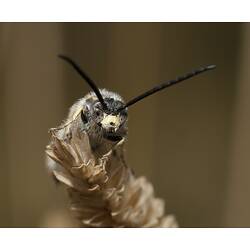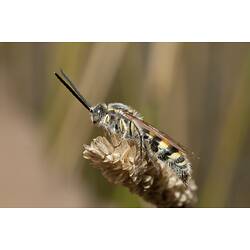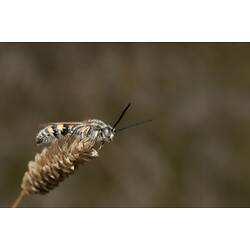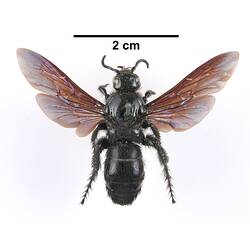General Description
Colourful, hairy wasps. These are large wasps for Australia, reaching 4 cm in length, though usually they are around 1-3 cm.
Biology
This family of wasps occurs around the world. Two main groups of Hairy Flower Wasps are seen in Victoria, Austroscolia soror and Campsomeris which occur in similar habitats. Like most insects that visit flowers, adult Hairy Flower Wasps drink nectar. Nectar provides them with food energy in the form of sugars that they use to power their wing muscles. Flower wasps are frequent visitors to flowers and due to their size and colour, are extremely obvious when drinking nectar. They are often seen visiting compost heaps or wood piles or flying around the dead stump of a tree. Adult females are large and powerful wasps and are quite capable of digging into compost heaps or saw-dust of a tree stump to find scarab beetle grubs (such as the Christmas Beetle group). Having located a beetle grub, the female stings and lays an egg inside it. The sting from the wasp does not kill the beetle grub but only paralyses it. There is a good reason why the female wasp does not kill the beetle grub. If the sting were to kill the beetle grub, then its tissue would immediately start to rot and decompose. When the wasp egg hatches inside the paralysed beetle grub it is surrounded by living tissue - the food that it needs to eat. The developing wasp larva knows which parts of the beetle grub to eat first to prolong the grub's life for as long as possible; thus maximizing the chances of complete development of the wasp larva. This behaviour makes these flower wasps parasitoids rather than parasites because the host is slowly killed. Parasites do not usually kill their host. Many species of wasps are parasitoids but others, such as paper wasps, kill their prey immediately. Flower wasps are solitary and do not make a nest or form a colony. If you see several flying around a compost heap or tree stump it simply means that several wasps have found the area.
Distribution
Throughout most parts of Australia.
More Information
-
Animal Type
-
Animal SubType
-
Brief Id
Large, colourful, hairy wasps.
-
Maximum Size
4 cm
-
Diet
Omnivore
-
Hazards
Flower wasps do have a well-developed sting but unlike a honey bee or a paper wasp, flower wasps do not have a nest or colony to protect, and are therefore not aggressive. They will not attack people for just being near where they are searching for food. The only way you could get stung by a flower wasp is to accidentally stand or sit on it. This can occur as the flower wasps fly at ground level looking for beetle grubs. There are no known reports of anyone having a problem with the sting of a flower wasp other than the pain of the sting itself but people who know they have an allergy to bee or wasp stings should avoid getting stung. Usually the application of a water-ice pack placed on the sting site will quickly reduce the pain and swelling. Unlike the honey bee, the barb of the sting will not remain in the victim's skin.
-
Endemicity
-
Commercial
No
-
Taxon Name
-
Kingdom
-
Phylum
-
Subphylum
-
Class
-
Order
-
Superfamily
-
Family







